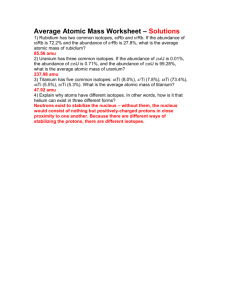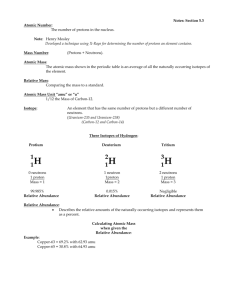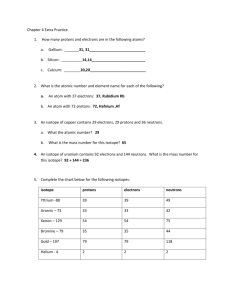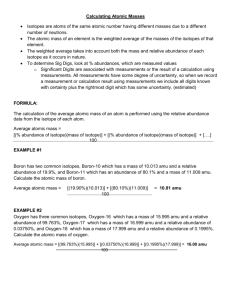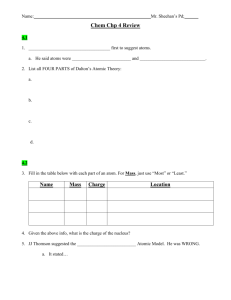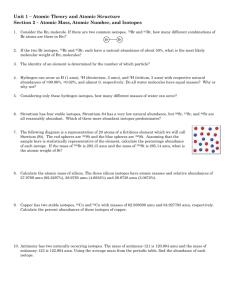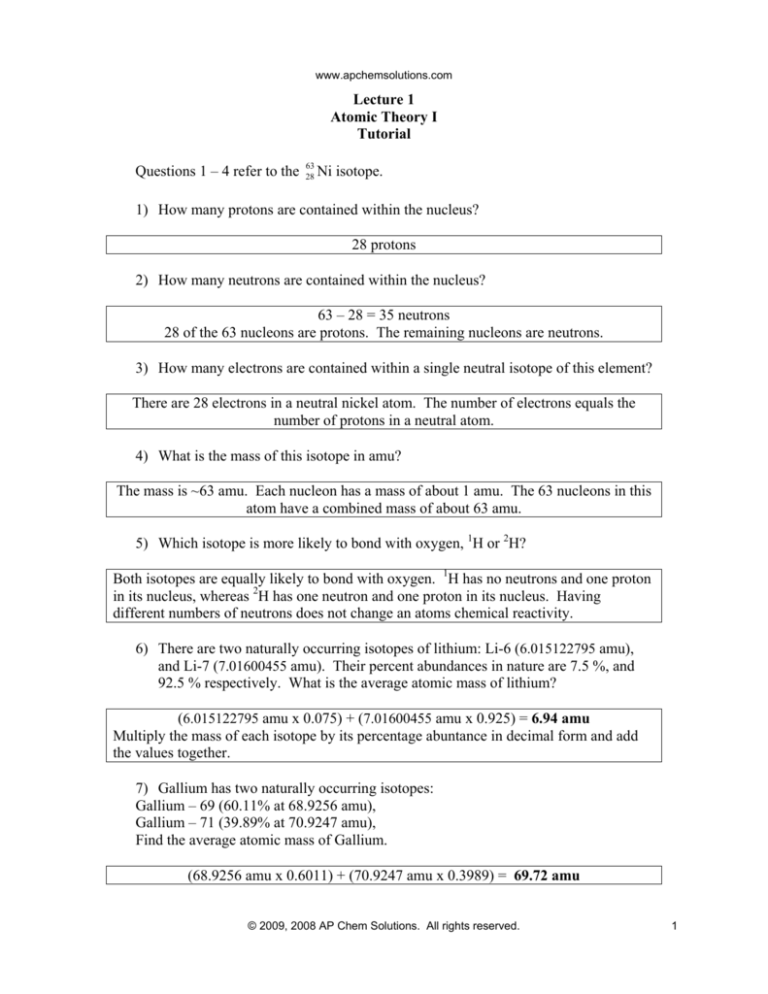
www.apchemsolutions.com
Lecture 1
Atomic Theory I
Tutorial
Questions 1 – 4 refer to the
63
28
Ni isotope.
1) How many protons are contained within the nucleus?
28 protons
2) How many neutrons are contained within the nucleus?
63 – 28 = 35 neutrons
28 of the 63 nucleons are protons. The remaining nucleons are neutrons.
3) How many electrons are contained within a single neutral isotope of this element?
There are 28 electrons in a neutral nickel atom. The number of electrons equals the
number of protons in a neutral atom.
4) What is the mass of this isotope in amu?
The mass is ~63 amu. Each nucleon has a mass of about 1 amu. The 63 nucleons in this
atom have a combined mass of about 63 amu.
5) Which isotope is more likely to bond with oxygen, 1H or 2H?
Both isotopes are equally likely to bond with oxygen. 1H has no neutrons and one proton
in its nucleus, whereas 2H has one neutron and one proton in its nucleus. Having
different numbers of neutrons does not change an atoms chemical reactivity.
6) There are two naturally occurring isotopes of lithium: Li-6 (6.015122795 amu),
and Li-7 (7.01600455 amu). Their percent abundances in nature are 7.5 %, and
92.5 % respectively. What is the average atomic mass of lithium?
(6.015122795 amu x 0.075) + (7.01600455 amu x 0.925) = 6.94 amu
Multiply the mass of each isotope by its percentage abuntance in decimal form and add
the values together.
7) Gallium has two naturally occurring isotopes:
Gallium – 69 (60.11% at 68.9256 amu),
Gallium – 71 (39.89% at 70.9247 amu),
Find the average atomic mass of Gallium.
(68.9256 amu x 0.6011) + (70.9247 amu x 0.3989) = 69.72 amu
© 2009, 2008 AP Chem Solutions. All rights reserved.
1
www.apchemsolutions.com
8) There are two naturally occurring isotopes of hydrogen: Hydrogen-1 (1.007825
amu) and Hydrogen-2 (2.014108 amu). What is the percentage abundance of
each isotope?
Let y represent the percent abundance of H-1 in decimal form. Thus, 1 – y is equal to the
percent abundance of H-2 in decimal form, as there are only two naturally occurring
isotopes of hydrogen.
1.007825 y + 2.014108 (1 – y) = 1.008
1.007825 y + 2.014108 – 2.014108 y = 1.008
-1.006283 y = -1.006
y = 0.9997
99.97% H-1, 0.03% H-2
9) Thallium has two stable isotopes: Thallium-203 (202.9723 g/mol) and Thallium205 (204.9744 g/mol). What is the percentage abundance of each isotope?
Let y represent the percent abundance of Tl-203 in decimal form. Thus, 1 – y is equal to
the percent abundance of Tl-205 in decimal form, as there are only two naturally
occurring isotopes of thallium.
202.9723 y + 204.9744 (1 – y) = 204.38
202.9723 y + 204.9744 – 204.9744 y = 204.38
-2.0021 y = -0.59
y = 0.29
29% Tl-203, 71% Tl-205
10) There are two naturally occurring isotopes of rhenium: Re-187 and Re-185.
Which isotope is the most abundant?
Re-187 is more abundant, as the average atomic mass of rhenium on the periodic table is
186.21 amu. As the average atomic mass of rhenium is closer to 187 than it is to 185, the
natural abundance of Re-187 must be greater.
11) What is the empirical formula for C8H18?
C4H9 The empirical formula is the smallest whole number ratio of one element to the
other in a compound.
12) What is the empirical formula for H2O?
H2O The empirical and molecular formulas are the same here. Water exists as one
oxygen atom and two hydrogen atoms; thus, the molecular formula is H2O. The smallest
whole number ratio of H to O is 2:1; thus, the empirical formula is also H2O.
© 2009, 2008 AP Chem Solutions. All rights reserved.
2


